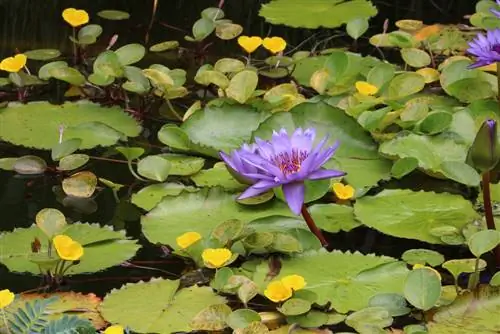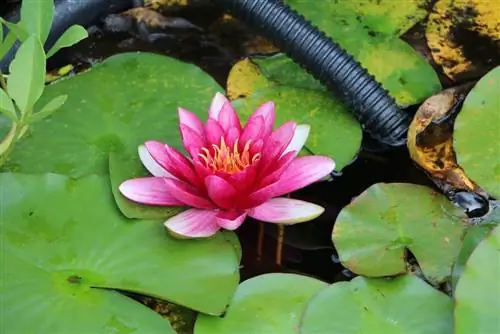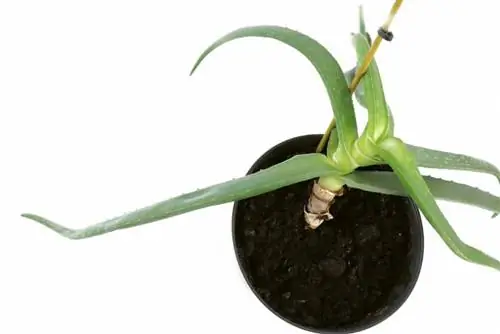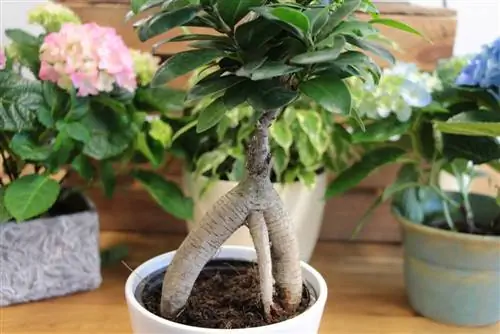- Author admin [email protected].
- Public 2023-12-17 03:39.
- Last modified 2025-01-24 12:45.
Water lilies impress with their beauty and elegant flowers. The conditions are very important so that these graceful aquatic plants can settle in well and be in full bloom in a timely manner. The plant only thrives in the right container, the right water and the right water depth. In addition, it will need to be repotted over time and as it grows.
Location
So that the water lilies can grow magnificently and produce beautiful flowers, choosing the right location is crucial. The distinctive flowers are purely aquatic plants and depend on appropriate conditions. First and foremost, these are not suitable for fast-flowing bodies of water, especially rivers. If you don't have your own pond, the graceful plants can also be planted in pots. The bottom of the water and its condition are also important so that the water lilies can take root well and feel comfortable in the long term. Since most water lily species are frost hardy, they can usually overwinter in water.
- Calm to stagnant ponds and lakes are ideal
- Also grow in slow-flowing streams
- Sunny location is important, shade is not tolerated well
- Need at least 4-6 hours of sunshine per day
- Muddy bottom is optimal
- Pay attention to low-lime, nutrient-rich and humus properties
Plants
When planting water lilies, please note that they are not planted directly in the bottom of the pond. Rather, the plants need a plant basket that gives them good support and is placed at a suitable water depth. The aquatic plants are available from specialist retailers in a container filled with the appropriate plant substrate and long-term fertilizer. The correct water depth depends on the species and variety and should be measured correctly. It is therefore important for the garden owner to find out in advance about the required depth. When buying, you should also pay attention to the growth rate, so that the water lilies can adapt well to the environment. So that the water lily can grow well in the beginning, the plant basket should initially be placed in the shallow part of the water for the first few weeks. Only after this acclimatization phase is it advisable to move to the final location in a slightly deeper area of the pond.
- Do not plant directly in the bottom of the pond
- Buy with plant basket, then position in suitable water depth
- Water depth is extremely important and varies depending on the variety
- Species for low water levels need 20-50 cm
- Species for medium water level need 40-80 cm
- Species for deeper water levels require 70-120 cm
- Plants should only be so deep that leaves can still float on top
- Also note the growth rate
- Only slow-growing varieties are suitable for small ponds and planters
- Plant stronger growing varieties only in larger ponds
Tip:
When new leaves form on the plant, these are the signal for the decline after acclimatization.
Repotting

After a few years at the latest, most water lilies become too big for the plant basket and have to be repotted. In this context, it makes sense to edit them out or even share them entirely. Especially if the water lily's ability to bloom has decreased after a few years, it should be divided and planted in another location. First of all, a new plant basket must be selected for repotting, which should correspond to the growth characteristics of the variety. The basket needs a good base so that the potting soil is not washed into the water. In addition, the water lily is supplied with the necessary nutrients via the plant basket, which must be placed there.
- First place coarse jute or burlap in the plant basket
- Next layer is the plant substrate
- Garden or potting soil mixed with clay and sand is ideal
- Soil should contain no or only a very small amount of peat
- Special water lily soil is available from specialist retailers
- Afterwards the fertilizer is added
- Long-term fertilizer made from fertilizer balls, horn shavings or bone meal is ideal
- Separate the strongest sections of the rhizome
- Lastly, take the water lily out of the old pot and embed it in the new one
- Root ball should be flush with the top edge of the basket
- Cover well with substrate, including the gaps
- Buds and a piece of the rhizome should protrude from the plant substrate
- Put the divided water lilies back into the pond one at a time
- Choose new locations
Plant basket
In order to choose the right plant basket, the size, root type and vigor of the variety are crucial. The basket must be able to survive the conditions in the water for several years without being damaged. Pay attention to plant baskets with fine meshes, which prevent the substrate from being washed out. Nevertheless, these meshes should still be wide enough so that the roots can spread into the bottom of the pond without disturbing obstacles.
- Plant baskets made of a non-rotting material, for example plastic
- Bulb-like, thickened roots need a narrow and deep plant basket
- Rhizoma-like roots need a flat and wide plant basket
- For small ponds, a basket size of 2-10 liters is suitable
- For medium-sized ponds, the basket size is 5-10 liters
- For large ponds, 15-30 liters in the basket are perfect






